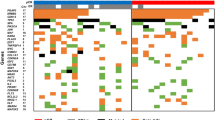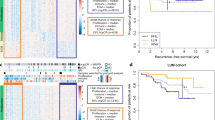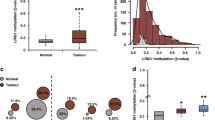Abstract
Targeting of histone methylation has therapeutic potential in oncology. Here, we provide proof-of-principle that pharmacological inhibition of KDM5 histone-demethylases is a new strategy for the personalized treatment of HER2+ breast cancer. The anti-proliferative effects of the prototype of a new class of selective KDM5-inhibitors (KDM5-inh1) are evaluated in 40 cell lines, recapitulating the heterogeneity of breast cancer. This analysis demonstrates that HER2+ cells are particularly sensitive to KDM5 inhibition. The results are confirmed in an appropriate in vivo model with a close structural analog (KDM5-inh1A). RNA-seq data obtained in HER2+ BT-474 cells exposed to KDM5-Inh1 indicate that the compound alters expression of numerous genes downstream of the ERBB2 gene-product, HER2. In selected HER2-positive breast-cancer cells, we demonstrate synergistic interactions between KDM5-inh1 and HER2-targeting agents (trastuzumab and lapatinib). In addition, HER2+ cell lines with innate and acquired resistance to trastuzumab show sensitivity to KDM5-inh1. The levels of KDM5A/B/C proteins, which are selectively targeted by the agent, have no significant association with KDM5-inh1 responsiveness across our panel of breast-cancer cell lines, suggesting the existence of other determinants of sensitivity. Using RNA-seq data of the breast-cancer cell lines we generate a gene-expression model that is a robust predictor of KDM5-inh1 sensitivity. In a test set of breast cancers, this model predicts sensitivity to the compound in a large fraction of HER2+ tumors. In conclusion, KDM5 inhibition has potential in the treatment of HER2+ breast cancer and our gene-expression model can be developed into a diagnostic tool for the selection of patients.
This is a preview of subscription content, access via your institution
Access options
Subscribe to this journal
Receive 50 print issues and online access
$259.00 per year
only $5.18 per issue
Buy this article
- Purchase on Springer Link
- Instant access to full article PDF
Prices may be subject to local taxes which are calculated during checkout







Similar content being viewed by others
References
Regan MM, Neven P, Giobbie-Hurder A, Goldhirsch A, Ejlertsen B, Mauriac L, et al. Assessment of letrozole and tamoxifen alone and in sequence for postmenopausal women with steroid hormone receptor-positive breast-cancer: the BIG 1-98 randomised clinical trial at 8.1 years median follow-up. Lancet Oncol. 2011;12:1101–8.
Cejalvo JM, Martinez de Duenas E, Galvan P, Garcia-Recio S, Burgues Gasion O, Pare L, et al. Intrinsic subtypes and gene expression profiles in primary and metastatic breast-cancer. Cancer Res. 2017;77:2213–21.
Moldovan L, Mitroi A, Petrescu CM, Aschie M. Classification of breast carcinomas according to gene expression profiles. J Med Life. 2013;6:14–17.
Perou C. M., Borresen-Dale A. L. Systems biology and genomics of breast-cancer. Cold Spring Harb Perspect Biol 2011; 3. https://doi.org/10.1101/cshperspect.a003293.
Bolis M, Garattini E, Paroni G, Zanetti A, Kurosaki M, Castrignano T, et al. Network-guided modeling allows tumor-type independent prediction of sensitivity to all-trans-retinoic acid. Ann Oncol. 2017;28:611–21.
Centritto F, Paroni G, Bolis M, Garattini SK, Kurosaki M, Barzago MM, et al. Cellular and molecular determinants of all-trans retinoic acid sensitivity in breast-cancer: Luminal phenotype and RARalpha expression. EMBO Mol Med. 2015;7:950–72.
Basse C, Arock M. The increasing roles of epigenetics in breast-cancer: Implications for pathogenicity, biomarkers, prevention and treatment. Int J Cancer. 2015;137:2785–94.
Strahl BD, Allis CD. The language of covalent histone modifications. Nature. 2000;403:41–5.
Rosenfeld JA, Wang Z, Schones DE, Zhao K, DeSalle R, Zhang MQ. Determination of enriched histone modifications in non-genic portions of the human genome. BMC Genom. 2009;10:143.
Brustel J, Tardat M, Kirsh O, Grimaud C, Julien E. Coupling mitosis to DNA replication: the emerging role of the histone H4-lysine 20 methyltransferase PR-Set7. Trends Cell Biol. 2011;21:452–60.
Pedersen MT, Helin K. Histone demethylases in development and disease. Trends Cell Biol. 2010;20:662–71.
Taylor-Papadimitriou J, Burchell J. JARID1/KDM5 demethylases as cancer targets? Expert Opin Ther Targets. 2017;21:5–7.
Berger SL. The complex language of chromatin regulation during transcription. Nature. 2007;447:407–12.
Wang GG, Song J, Wang Z, Dormann HL, Casadio F, Li H, et al. Haematopoietic malignancies caused by dysregulation of a chromatin-binding PHD finger. Nature. 2009;459:847–51.
Zeng J, Ge Z, Wang L, Li Q, Wang N, Bjorkholm M, et al. The histone demethylase RBP2 Is overexpressed in gastric cancer and its inhibition triggers senescence of cancer cells. Gastroenterology. 2010;138:981–92.
Teng YC, Lee CF, Li YS, Chen YR, Hsiao PW, Chan MY, et al. Histone demethylase RBP2 promotes lung tumorigenesis and cancer metastasis. Cancer Res. 2013;73:4711–21.
Hou J, Wu J, Dombkowski A, Zhang K, Holowatyj A, Boerner JL, et al. Genomic amplification and a role in drug-resistance for the KDM5A histone demethylase in breast-cancer. Am J Transl Res. 2012;4:247–56.
Cao J, Liu Z, Cheung WK, Zhao M, Chen SY, Chan SW, et al. Histone demethylase RBP2 is critical for breast-cancer progression and metastasis. Cell Rep. 2014;6:868–77.
Barrett A, Santangelo S, Tan K, Catchpole S, Roberts K, Spencer-Dene B, et al. Breast-cancer associated transcriptional repressor PLU-1/JARID1B interacts directly with histone deacetylases. Int J Cancer. 2007;121:265–75.
Roesch A, Fukunaga-Kalabis M, Schmidt EC, Zabierowski SE, Brafford PA, Vultur A, et al. A temporarily distinct subpopulation of slow-cycling melanoma cells is required for continuous tumor growth. Cell. 2010;141:583–94.
Guo X, Zhang Q. The emerging role of histone demethylases in renal cell carcinoma. J Kidney Cancer VHL. 2017;4:1–5.
Wang Q, Wei J, Su P, Gao P. Histone demethylase JARID1C promotes breast-cancer metastasis cells via down regulating BRMS1 expression. Biochem Biophys Res Commun. 2015;464:659–66.
Akimoto C, Kitagawa H, Matsumoto T, Kato S. Spermatogenesis-specific association of SMCY and MSH5. Genes Cells. 2008;13:623–33.
Li N, Dhar SS, Chen TY, Kan PY, Wei Y, Kim JH, et al. JARID1D Is a suppressor and prognostic marker of prostate cancer invasion and metastasis. Cancer Res. 2016;76:831–43.
Pasini D, Hansen KH, Christensen J, Agger K, Cloos PA, Helin K. Coordinated regulation of transcriptional repression by the RBP2 H3K4 demethylase and Polycomb-Repressive Complex 2. Genes Dev. 2008;22:1345–55.
Tumber A, Nuzzi A, Hookway ES, Hatch SB, Velupillai S, Johansson C, et al. Potent and selective KDM5 inhibitor stops cellular demethylation of H3K4me3 at transcription start sites and proliferation of MM1S myeloma cells. Cell Chem Biol. 2017;24:371–80.
Labbe RM, Holowatyj A, Yang ZQ. Histone lysine demethylase (KDM) subfamily 4: structures, functions and therapeutic potential. Am J Transl Res. 2013;6:1–15.
Yamamoto S, Wu Z, Russnes HG, Takagi S, Peluffo G, Vaske C, et al. JARID1B is a luminal lineage-driving oncogene in breast-cancer. Cancer Cell. 2014;25:762–77.
Catchpole S, Spencer-Dene B, Hall D, Santangelo S, Rosewell I, Guenatri M, et al. PLU-1/JARID1B/KDM5B is required for embryonic survival and contributes to cell proliferation in the mammary gland and in ER+ breast-cancer cells. Int J Oncol. 2011;38:1267–77.
Gajria D, Chandarlapaty S. HER2-amplified breast-cancer: mechanisms of trastuzumab resistance and novel targeted therapies. Expert Rev Anticancer Ther. 2011;11:263–75.
Sahlberg KK, Hongisto V, Edgren H, Makela R, Hellstrom K, Due EU, et al. The HER2 amplicon includes several genes required for the growth and survival of HER2 positive breast-cancer cells. Mol Oncol. 2013;7:392–401.
Kute T, Lack CM, Willingham M, Bishwokama B, Williams H, Barrett K, et al. Development of Herceptin resistance in breast-cancer cells. Cytom A. 2004;57:86–93.
Valabrega G, Capellero S, Cavalloni G, Zaccarello G, Petrelli A, Migliardi G, et al. HER2-positive breast-cancer cells resistant to trastuzumab and lapatinib lose reliance upon HER2 and are sensitive to the multitargeted kinase inhibitor sorafenib. Breast-Cancer Res Treat. 2011;130:29–40.
Sarter K, Leimgruber E, Gobet F, Agrawal V, Dunand-Sauthier I, Barras E, et al. Btn2a2, a T cell immunomodulatory molecule coregulated with MHC class II genes. J Exp Med. 2016;213:177–87.
Kennedy JM, Fodil N, Torre S, Bongfen SE, Olivier JF, Leung V, et al. CCDC88B is a novel regulator of maturation and effector functions of T cells during pathological inflammation. J Exp Med. 2014;211:2519–35.
Araki K, Miyoshi Y. Mechanism of resistance to endocrine therapy in breast-cancer: the important role of PI3K/Akt/mTOR in estrogen receptor-positive, HER2-negative breast-cancer. Breast-cancer. 2018;25:392–401.
Rodrigues LM, Chung YL, Al Saffar NM, Sharp SY, Jackson LE, Banerji U, et al. Effects of HSP90 inhibitor 17-allylamino-17-demethoxygeldanamycin (17-AAG) on NEU/HER2 overexpressing mammary tumours in MMTV-NEU-NT mice monitored by Magnetic Resonance Spectroscopy. BMC Res Notes. 2012;5:250.
Citri A, Gan J, Mosesson Y, Vereb G, Szollosi J, Yarden Y. Hsp90 restrains ErbB-2/HER2 signalling by limiting heterodimer formation. EMBO Rep. 2004;5:1165–70.
Esteva FJ, Guo H, Zhang S, Santa-Maria C, Stone S, Lanchbury JS, et al. PTEN, PIK3CA, p-AKT, and p-p70S6K status: association with trastuzumab response and survival in patients with HER2-positive metastatic breast-cancer. Am J Pathol. 2010;177:1647–56.
Schulz R, Marchenko ND, Holembowski L, Fingerle-Rowson G, Pesic M, Zender L, et al. Inhibiting the HSP90 chaperone destabilizes macrophage migration inhibitory factor and thereby inhibits breast tumor progression. J Exp Med. 2012;209:275–89.
Fabi A, Malaguti P, Vari S, Cognetti F. First-line therapy in HER2 positive metastatic breast-cancer: is the mosaic fully completed or are we missing additional pieces? J Exp Clin Cancer Res. 2016;35:104.
Geyer CE, Forster J, Lindquist D, Chan S, Romieu CG, Pienkowski T, et al. Lapatinib plus capecitabine for HER2-positive advanced breast-cancer. N Engl J Med. 2006;355:2733–43.
Calabrich A, Fernandes Gdos S, Katz A. Trastuzumab: mechanisms of resistance and therapeutic opportunities. Oncol (Williston Park). 2008;22:1250–8. discussion 1259, 1263
Paroni G, Fratelli M, Gardini G, Bassano C, Flora M, Zanetti A, et al. Synergistic antitumor activity of lapatinib and retinoids on a novel subtype of breast-cancer with coamplification of ERBB2 and RARA. Oncogene. 2012;31:3431–43.
Acknowledgements
Grants from the Associazione Italiana per la Ricerca contro il Cancro (AIRC) and the Fondazione Italo Monzino to Enrico Garattini were fundamental for the completion of this work. We would like to acknowledge the help of Mr. Alessandro Soave for the artwork and Laura Pasetto for the densitometric analyses.
Authors contribution
GP and AZ performed the experimental work involving the use of cell lines; MB and MF were involved in the computational analysis of the gene-expression datasets; PU developed the mathematical algorithms and models necessary for the development of the KDM5I-score; KH, PS, and LOS were involved in the design and conduction of the in vivo experiments; MT supervised some of the phases of the work and wrote the manuscript; EG and RMN designed and supervised the entire study and wrote the manuscript.
Author information
Authors and Affiliations
Corresponding author
Ethics declarations
Conflict of interest
Richard M. Neve is an employee of Gilead Sciences which developed and patented the proprietary KDM5 inhibitors used in the present study. The remaining authors declare that they have no conflict of interest.
Supplementary Information
Rights and permissions
About this article
Cite this article
Paroni, G., Bolis, M., Zanetti, A. et al. HER2-positive breast-cancer cell lines are sensitive to KDM5 inhibition: definition of a gene-expression model for the selection of sensitive cases. Oncogene 38, 2675–2689 (2019). https://doi.org/10.1038/s41388-018-0620-6
Received:
Revised:
Accepted:
Published:
Issue Date:
DOI: https://doi.org/10.1038/s41388-018-0620-6
This article is cited by
-
Proximity labeling reveals a new in vivo network of interactors for the histone demethylase KDM5
Epigenetics & Chromatin (2023)
-
A truncated and catalytically inactive isoform of KDM5B histone demethylase accumulates in breast cancer cells and regulates H3K4 tri-methylation and gene expression
Cancer Gene Therapy (2023)
-
Drawing a line between histone demethylase KDM5A and KDM5B: their roles in development and tumorigenesis
Experimental & Molecular Medicine (2022)
-
JMJD family proteins in cancer and inflammation
Signal Transduction and Targeted Therapy (2022)
-
The emerging role of KDM5A in human cancer
Journal of Hematology & Oncology (2021)



